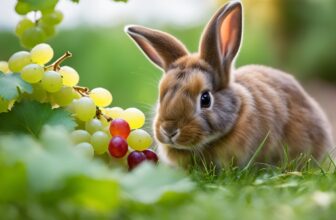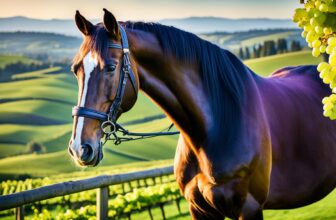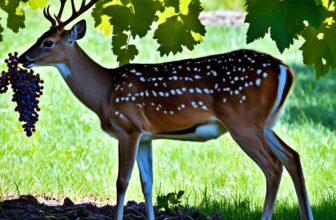Deer and Grapes: Do Deer Eat This Fruit?
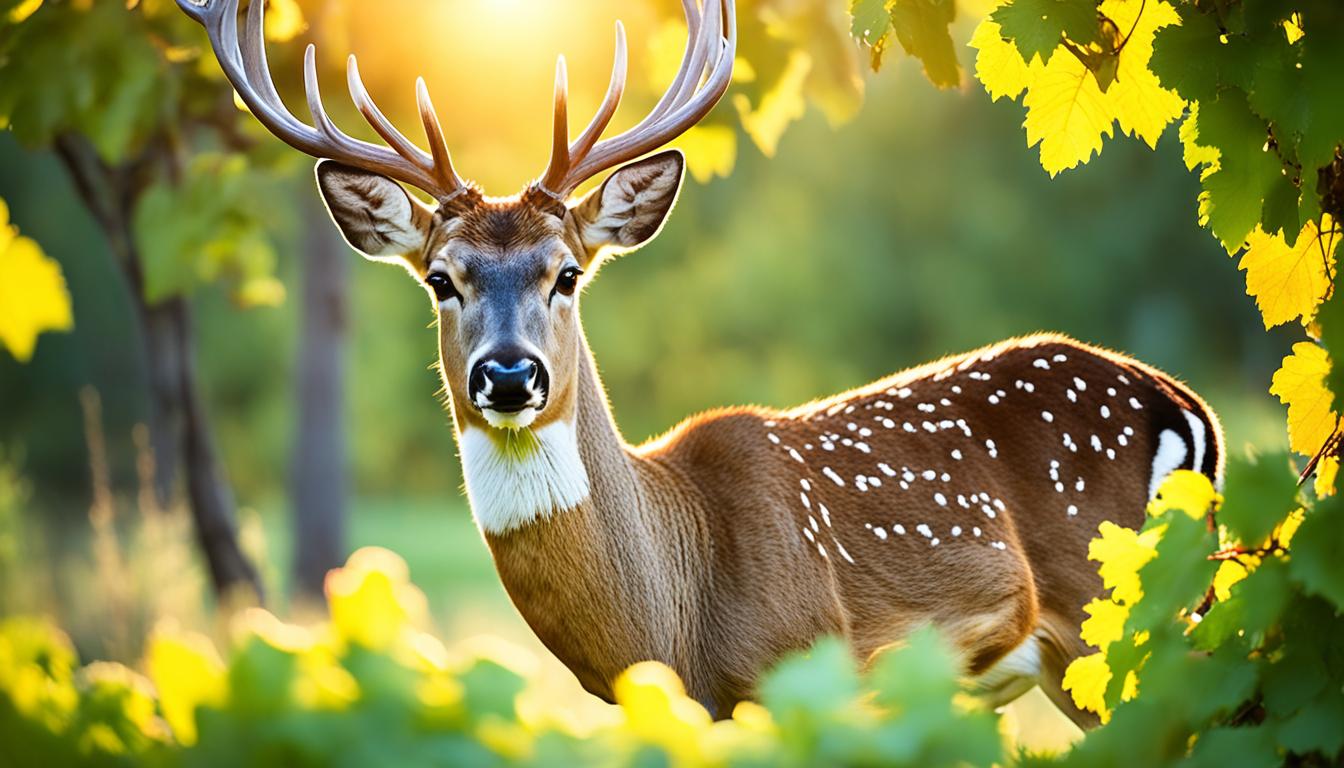
As a backyard gardener or grape enthusiast, you may have wondered: do deer actually eat grapes? The answer may surprise you. Deer are known to have quite a diverse diet, and grapes, both the fruit and the vines, can be a tempting treat for these herbivores. But how much of a problem are deer when it comes to your prized grape harvest? Let’s explore the relationship between deer and this popular fruit.
Key Takeaways
- Deer are known to enjoy both the fruit and tender leaves/twigs of grape vines.
- Grape vines can be a significant food source for deer, especially in late summer and early fall when the grapes ripen.
- Deer can cause substantial damage to young, newly established grape vines by stripping the leaves and fruit.
- Effective deer deterrents, such as tall, electrified fencing, are often necessary to protect grape crops from deer predation.
- Understanding deer feeding habits and preferences can help grape growers plan and manage their vineyards to minimize the impact of these herbivores.
The Deer’s Love for Grapes
Grape vines are a prime target for hungry deer. Numerous eyewitness accounts have documented deer enthusiastically grazing on grape leaves, shoots, and ripe fruit. Whitetail deer, in particular, display a strong preference for grapes and grape vines, devouring them with relish.
Grape Vines: A Favorite Snack for Deer
Deer find grape vines, especially young and tender ones, to be an irresistible delicacy. The damage they can inflict on vineyards is substantial, as they strip leaves, consume the fruit, and even trample the vines underfoot. This behavior can lead to significant losses for grape growers if proper deterrents are not implemented.
The problem is exacerbated by the fact that deer have a diverse diet, with a particular fondness for forbs (herbaceous flowering plants) over other food sources. Grapes and grape vines rank highly among their preferred foods, making them a constant threat to vineyards.
“Deer can go over a 6 feet fence, making it ineffective in deterring them.”
According to wildlife experts, the best way to identify deer’s preferred food sources in a specific region is by observing the signs of browsing in the area. Trampled plants, crushed fruits, and ragged, broken ends of branches are all telltale signs of deer activity.
Protecting vineyards from deer requires a multi-faceted approach, as a single deterrent method is often not enough to keep these determined foragers at bay. A combination of tactics, such as fencing, repellents, and other deterrents, is necessary to effectively safeguard grape vines from deer damage.
Protecting Your Vineyard from Deer
As a grape grower, protecting your vineyard from deer is a critical aspect of wildlife management. Deer can pose a significant threat to the health and productivity of your grape vines, consuming up to 50% of your Tempranillo grapes if left unchecked. Implementing an effective deer deterrent system is essential to safeguarding your valuable crop and ensuring a bountiful harvest.
Fencing: The Most Effective Deterrent
The most reliable method for protecting your vineyard from deer is the installation of tall, deer-resistant fencing. A 7-foot-tall fence spanning over a mile has proven to be highly effective in keeping deer out of the grape-growing area. This exclusionary barrier, combined with an electric fence, creates a comprehensive defense system that deters deer from accessing your valuable vines.
Other Deer-Deterrent Methods
In addition to fencing, grape growers can employ various other deer-deterrent methods to enhance their vineyard protection efforts. Motion-activated sprinklers, reflective devices, and repellents can all play a role in deterring deer from your property. For example, Nite Guard Solar Lights mimic the blinking eyes of a nocturnal predator, triggering the “fight or flight” response in deer and birds, while Plantskydd Animal Repellent has been shown to reduce damage by over 30% on 1,000 acres of treated vineyards.
Implementing a comprehensive deer management plan, which combines multiple deterrent strategies, is the key to successfully protecting your vineyard from deer. By being proactive and utilizing a variety of proven techniques, you can safeguard your grape-growing operations and ensure a thriving, deer-free vineyard.
| Deer-Deterrent Method | Effectiveness | Application Details |
|---|---|---|
| Nite Guard Repellent Tape | Triggers “fight or flight” instinct in deer and birds | Place at 6-7 ft off the ground to deter birds, and at eye level to deter ground animals like deer |
| Nite Guard Solar Lights | Mimic blinking eyes of nocturnal predator, deterring deer and birds | Install at various levels off the ground to deter both land and sky dwelling creatures |
| Plantskydd Animal Repellent | 30% improvement in yield on 1,000 acres treated | Apply when buds are swelling and again when vines are 3-4 inches of growth; use ground application on borders of heavy-hit areas |
Deer Diet: Do Deer Eat Grapes?
Deer are indeed known to eat grapes, both the fruit and the leaves of grape vines. Their fondness for grapes is well-documented, with numerous eyewitness accounts and reports of deer causing damage in vineyards. While grapes are not a primary component of a deer’s natural diet, they are considered a favored snack that deer will seek out and consume when available.
According to research, deer feed at dawn and dusk when they typically browse for food. A single slice of bread can be lethal for a deer, and they can starve to death with a gut full of hay due to its lack of nutrition. Deer enjoy a variety of fruits, including apples, grapes, blueberries, cranberries, raisins, bananas, and ripe pears.
Interestingly, deer are not interested in certain plants such as oregano, sage, rosemary, English and Spanish lavenders, and arugula. They leave small black poop balls as waste, and some deer buddies may leave behind fawns as caregivers take over. Deer feeding can be a rewarding hobby, although an expensive one, as their feeding needs are substantial.
“On average, an adult white-tailed deer consumes about 5-7 pounds of food per day, indicating their substantial feeding needs.”
White-tailed deer, in particular, prefer trees and shrubs such as white cedar, birches, aspens, and American yew, which are among their favorite food sources. During the winter months, when food sources become scarcer, it is common for people to provide supplemental feed deer to help sustain them.
However, it’s important to note that local laws may regulate feeding wildlife, with some states prohibiting deer feeding altogether. Gradually introducing new foods to deer is also crucial, as their systems take 2-4 weeks to adjust to a new diet, emphasizing the importance of a gradual dietary transition.
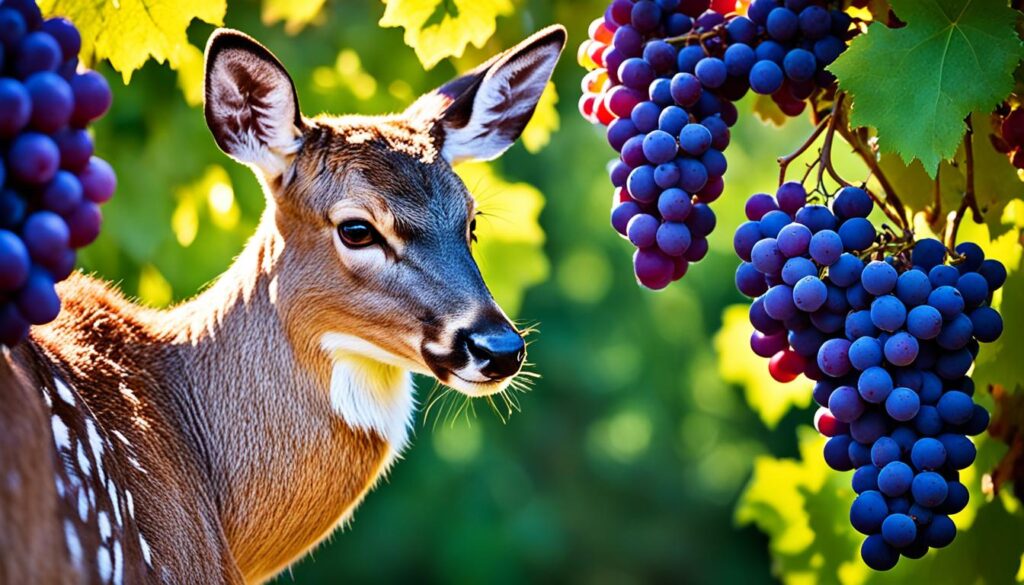
In conclusion, deer’s love for grapes is well-established, and their fondness for this fruit is evident in the numerous reports of their presence in vineyards. While grapes are not a primary component of their diet, they are considered a favored snack that deer will seek out and consume when available, highlighting the deer’s diverse diet preferences and wild deer feeding habits.
Grapes vs. Raisins: What’s the Difference?
While both grapes and raisins (dried grapes) are enjoyed by deer, there are some notable nutritional differences between the two. Understanding these variations can provide valuable insights into the dietary preferences and needs of these captivating creatures.
Nutritional Comparison
Raisins are significantly more calorie-dense than fresh grapes, containing almost four times the number of calories per serving. However, grapes are richer in certain vitamins and antioxidants, such as vitamin C and resveratrol. On the other hand, raisins have higher concentrations of minerals like copper and iron.
| Nutrient | Grapes | Raisins |
|---|---|---|
| Calories (per 100g) | 67 | 299 |
| Vitamin C (mg) | 3.7 | 0.3 |
| Resveratrol (mg) | 0.11 | 0.03 |
| Copper (mg) | 0.12 | 0.64 |
| Iron (mg) | 0.36 | 2.93 |
While deer can safely consume both grapes and raisins in moderation, the distinct nutritional profiles of these two fruits may influence their dietary preferences and selections. Deer’s natural inclination towards sweet and calorie-dense foods could contribute to their attraction to raisins, while the higher vitamin and antioxidant content of grapes may also appeal to their nutritional needs.
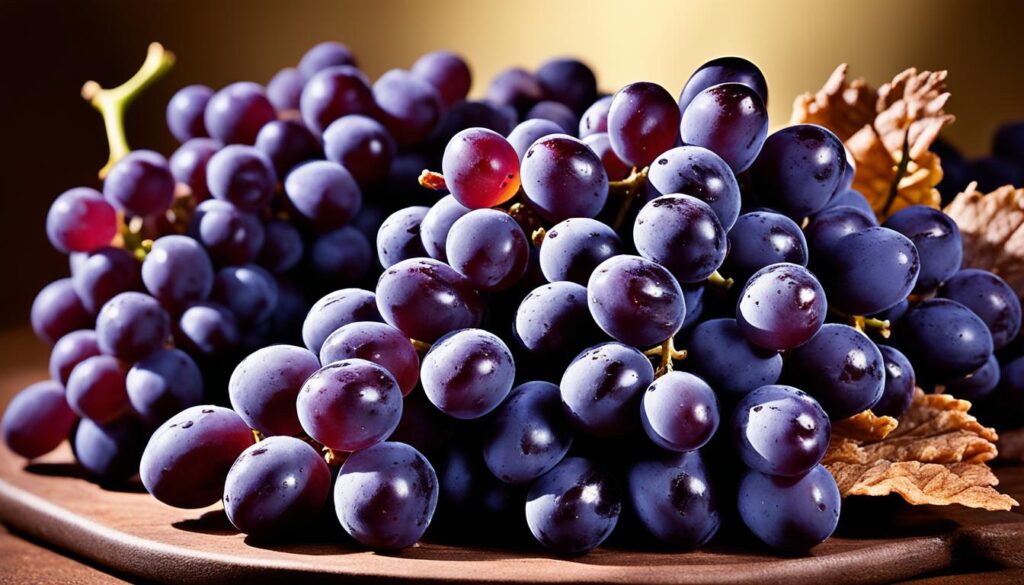
“Grapes have been part of the Indigenous North American diet for over 10,000 years, with various Native American nations utilizing them for food, medicine, and other purposes.”
By understanding the nutritional differences between grapes and raisins, wildlife enthusiasts and deer management professionals can gain valuable insights into the dietary preferences and needs of these fascinating animals. This knowledge can inform effective strategies for managing deer populations and their interactions with human environments, ultimately fostering a harmonious coexistence.
Other Dried Fruits Deer Enjoy
Deer are not only fond of grapes and raisins, but they also demonstrate a taste for a variety of other dried fruits. As opportunistic foragers, these curious creatures readily consume any fallen or dried fruits they encounter in their natural habitat. From personal experience, deer have been observed enjoying the dehydrated sweetness of cranberries, currants, and apricots.
Raisins, in particular, are a favorite snack for deer. These dried grapes are packed with carbohydrates and calories, providing the animals with a substantial energy boost. Deer are enthusiastic about raisins, often seeking them out and devouring them with gusto. However, it’s important to note that while deer can safely consume raisins in moderation, these dried fruits should not make up a significant portion of their diet, as they are high in sugar and carbohydrates.
In addition to grapes and raisins, deer have also been known to feast on grape vine leaves. This versatile part of the plant offers a tasty and nutritious treat for these backyard wildlife visitors. Deer’s love for grapes and their derivatives is well-documented, making them a common concern for gardeners and vineyard owners alike when it comes to backyard wildlife management and garden protection.
“Deer will readily consume any fallen or dried fruits they encounter in their natural habitat, including cranberries, currants, and apricots.”
While deer’s fondness for dried fruits may provide an occasional treat, it’s crucial to understand that these sugary snacks should be offered in moderation. Overindulgence in high-calorie dried fruits can lead to health issues for the deer. As responsible backyard wildlife management enthusiasts, it’s essential to strike a balance between providing natural food sources and ensuring the deer’s overall well-being.
By recognizing deer’s diverse taste preferences and implementing appropriate garden protection measures, gardeners and vineyard owners can coexist peacefully with these fascinating deer eating dried fruits in their backyard ecosystems.
Feeding Wild Deer: Considerations
As deer populations continue to thrive in many regions, the temptation to feed these majestic creatures may arise. However, before considering feeding wild deer, it’s crucial to understand the legal implications and potential consequences of such actions.
Legal Implications
In numerous areas, intentionally feeding wild deer is either prohibited or heavily regulated. This is often due to concerns about the transmission of diseases, the disruption of natural feeding patterns, and the potential for conflicts between deer and humans. Wildlife conservation efforts aim to maintain the delicate balance of ecosystems, and uncontrolled feeding can upset this balance.
Moderation is Key
Even in regions where feeding deer is permitted, it should be done with great moderation. Deer are adapted to thrive on their natural forage, and sudden changes in their diet can be harmful to their health. Providing supplemental feeding should be a minimal part of their overall diet, focusing on delivering a balanced and nutritious selection of foods.
It’s important to note that in some areas, such as Pennsylvania, feeding deer is outright illegal due to the risks of disease transmission. Similarly, in McCall City, Idaho, a $100 fine has been imposed for feeding deer within the city limits. These legal guidelines are in place to protect both the deer and the surrounding community.
While the desire to care for and support wild deer may be well-intentioned, it’s crucial to prioritize the long-term well-being of these animals and the overall ecosystem. By understanding the legal considerations and practicing moderation, individuals can contribute to the responsible management of deer populations and the conservation of wildlife.
Conclusion
Deer and grapes have a complex relationship, with deer exhibiting a strong preference for grape vines and the sweet fruit. From vineyards to backyard gardens, grape growers and homeowners must be proactive in implementing comprehensive deer management strategies to safeguard their crops and ensure the long-term viability of their grape-growing efforts.
The most effective method of protecting grapes from deer remains the installation of tall, electrified fencing as an exclusionary barrier. While deer can safely consume grapes and raisins in moderation, these should not make up a significant portion of their diet. Careful monitoring, habitat management, and the use of deterrents like noise devices can also play a role in mitigating deer damage to grape-growing areas.
By understanding the dynamics between deer and grape management, grape growers and homeowners can strike a balance that preserves the ecological harmony while protecting their valuable grape crops. Through continued research, education, and collaboration, the industry can find innovative solutions to address the challenges posed by deer and other wildlife, ensuring the sustainability of grape-growing for generations to come.



